The Great War Centenary: Part Six, The Trenches
By the end of 1915 all hopes of a quick path to peace had evaporated. Germany with much greater numbers on its side, thanks to its new alliance with the Ottoman Empire, could withstand a war of attrition. The Russians had been defeated at Tannenberg, relieving the pressure from the East. The war would drag on and the horror would grow...
This is Part Six of a series of posts leading up to the centenary of the end of The Great War on November 11, 2018. For details of the defeat of Russia in the Battle of Tannenberg, and the war at sea paving the way to America joining the War, please see The Great War Centenary: Part Five, The East and At Sea
.
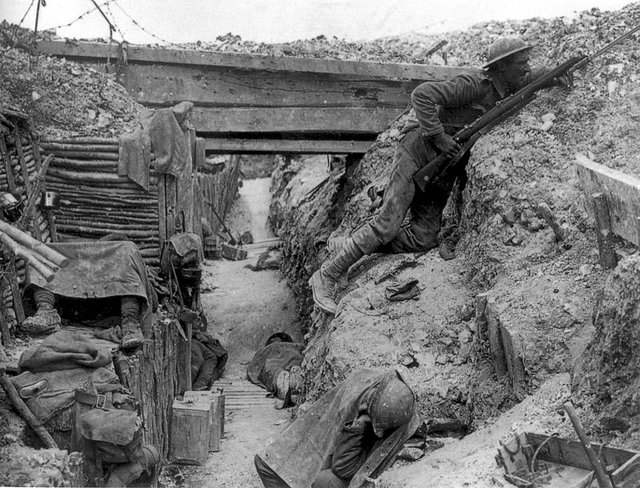
The trenches
Life in the trenches of World War one was horrific. It was a life of mud, death, rats and the stench of rotting bodies. The soldiers would spend anxious hours of boredom waiting for the next volley of machine-gun fire or artillery shelling. The poor wretches in these terrible trenches believed one thing for certain: they were going to die — if not by direct fire from the enemy or their own artillery shells, then by disease.
Trench warfare started in September 1914 after the Battle of Marne. The trenches lengthened as both sides attempted to outflank each other. By the end of November, there was a continuous line of trenches between Switzerland and the North Sea. Behind the frontline trenches was a mass of supply lines, storage facilities, workshops and headquarters — all the essential facilities for waging a war. This is where the bulk of the men were employed, with men in the frontline trenches being rotated every week or so.
Trench warfare was a fight over inches of land. It was, in essence, a defensive stalemate position typified by a lack of movement. Whenever an attempt was made to break the stalemate it usually caused a much higher casualty rate than the already horrific one at stasis. We will look at two of these battles fought from the trenches.
Verdun
The Battle of Verdun, 21 February to 15 December 1916, became the longest single battle in modern history. Erich von Falkenhayn, German Chief of General Staff, believed that the way to win this war of attrition would be to inflict mass casualties on the French army, sapping its will to fight. Then without its French allies, the British would have to sue for peace. The plan was to lure the French into a trap, forcing them to throw more troops in the battle and “bleed them white”.
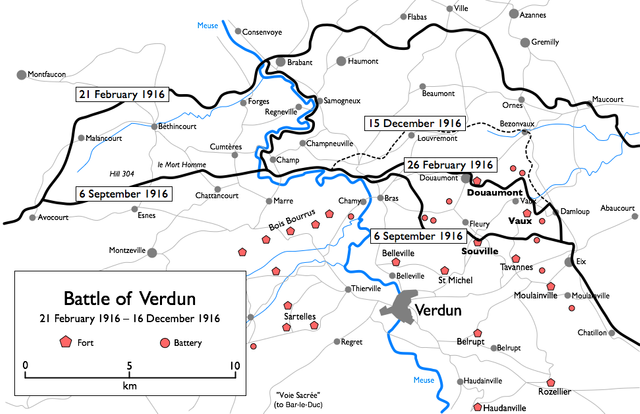
Verdun was chosen as the target for the attack because it had been built into one of the most heavily fortified strongholds along the border with Germany. By choosing a target that the French could not afford to lose, the Germans would slowly destroy the French forces, believing the German forces were superior.
The battle started with the Germans launching a massive, devastating artillery bombardment and then the steady advance of troops of the German Fifth Army under Crown Prince Wilhelm. The strongest of the forts were captured. Spurred on by the success, Prince Wilhelm changed von Falkenhayn's plan from a battle of attrition to prioritising the seizure of ground. The new offensive strategy caused German casualties to rise, equaling French casualties by the end of February.
General Philippe Petain was then given command of the French Second Army at Verdun. He reorganised the management of the troops in the trenches and support staff as well as establishing reliable support paths. He also greatly increased the number of artillery pieces at Verdun, leading to the Germans suffering equally from incessant shelling.
Ground was gained and lost, there was attack and counter-attack. And as the German offensive was reduced to reinforce the Somme front, the French gradually recaptured much of the ground lost and recovered their forts.
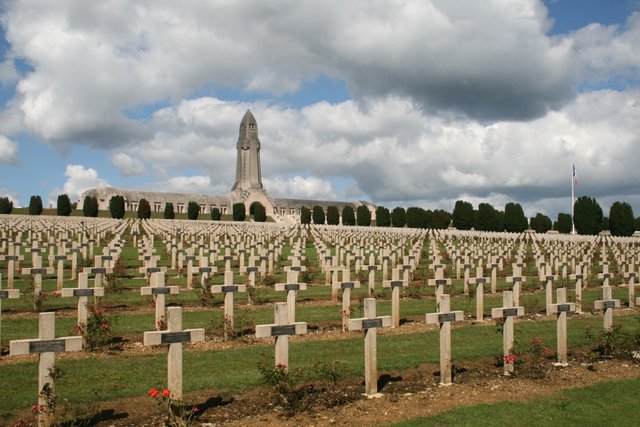
Verdun Memorial Cemetery
The battle had lasted for 303 days, the longest and one of the most costly in human history. It is estimated that there were some 377,000 French and 337,000 German casualties, a total of 714,000. An average of 70,000 casualties a month. Some historians put this figure even higher.
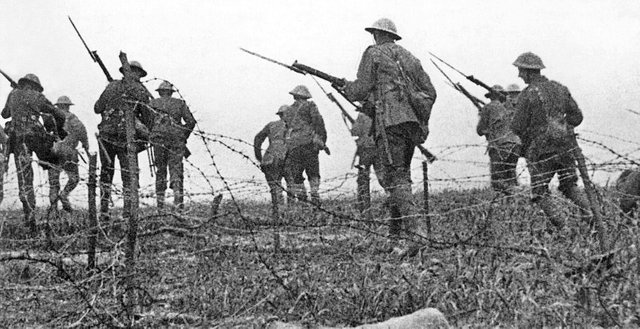
The Somme
In early 1916, the French proposed a joint Franco-British offensive astride the river Somme. But the French had taken heavy losses at the Battle of Verdun and so the British took on the major role. In late June 1916, when a few skirmishes broke out, the Germans withdrew a number of troops from Verdun to the Somme region.
On the morning of July 1, 1916, the Battle of the Somme started with a massive Allied artillery barrage. Over 250,000 shells were fired in just over an hour — a rate of 3,500 per minute. The bombardment was so intense that it could be heard north of London.
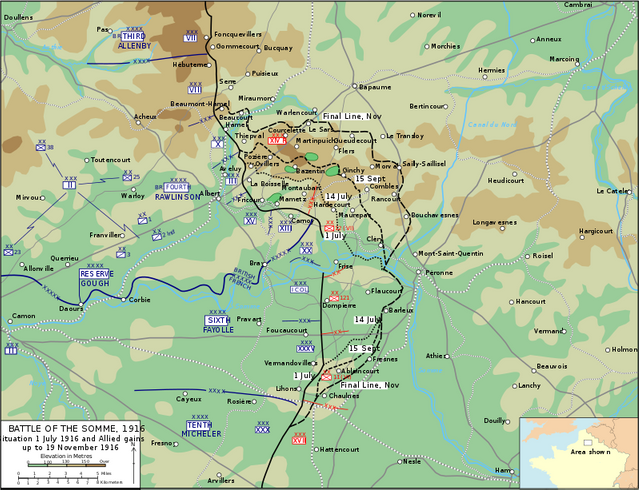
In a co-ordinated operation, mines were simultaneously blown up under German trenches and British and French forces attacked along a 40 km front.
As the British troops threw themselves at the Germans they were cut down in their thousands by German defenders. The earlier barrage had not incapacitated the Germans nor had it cut the barbed wire fences. The German defensive systems had remained intact, showing the strength and resilience of the German forces.
The advancing British soldiers were severely disadvantaged by having to carry 60 kg of equipment. They could hardly climb out of the trenches and could only stagger forward.
The British suffered huge losses on that first day of the offensive — the largest losses suffered by the British Army in a single day. There were 57,470 British casualties (19,200 killed), greater than the total combined British casualties in the Crimean, Boer, and Korean wars. In contrast, the French, with fewer divisions, suffered only around 2,000 casualties.
The Newfoundland Regiment, the only British Dominion force involved in the battle that day, was virtually wiped out. Of the 810 men, only 100 returned with only 68 available for roll call the next morning.
The French, with greater experience and better artillery, fared better. But in the following days, they had to pause their advance to allow the British forces to catch up to them. The Germans took advantage of this and regrouped, leading to the French taking a similar number of casualties as the British. The British command was inept. It considered the German defences to be on the verge of collapse, but it was unable to coordinate the Allied attacks leaving individual battalions exposed to German counter-attack.
The Germans were operating under orders to recover all lost land at all costs. This caused the number of German casualties to soar as they lost territory and then fought to take it back again under worse conditions.
On 15 September the first tanks appeared. But it was another opportunity squandered by the British command since very few of the large numbers under production were deployed thereby forfeiting the chance of a great strategic surprise.
On the Eastern Front, the Germans were taking heavy casualties and so by November many German troops had been removed from the Somme region. The Somme offensive came to a muddy end on 13 November 1916.
The Battle of the Somme was one of the costliest battles of World War One. The Allied forces suffered over 620,000 casualties. The British Commonwealth losses amounted to some 420,000, including over 3,000 South Africans. The French, who had played an increasing part in the later stages, suffered over 200,000 casualties. The number of German casualties was between 465,000 and 600,000.
As one German officer wrote:
Somme. The whole history of the world cannot contain a more ghastly word.
This series on World War One will be concluded in Part Seven, tomorrow
Previous post in this series:
The Great War Centenary: Introduction
The Great War Centenary: Part One, The Tinderbox
The Great War Centenary: Part Two, The Spark
The Great War Centenary: Part Three, Invasion
The Great War Centenary: Part Four, Ottomans and Gallipoli
The Great War Centenary: Part Five, The East and At Sea
References:
https://www.historyonthenet.com/ww1-trenches-what-is-a-trench
https://en.wikipedia.org/wiki/Trench_warfare
https://www.iwm.org.uk/history/what-was-the-battle-of-verdun
https://en.wikipedia.org/wiki/Battle_of_Verdun
https://www.iwm.org.uk/history/5-things-you-need-to-know-about-the-battle-of-the-somme
https://en.wikipedia.org/wiki/Battle_of_the_Somme
https://www.history.com/topics/world-war-i/battle-of-the-somme
https://www.britannica.com/event/First-Battle-of-the-Somme
Also posted on Weku, @tim-beck, 2018-11-11
What is staggering with the graves is that one cross represents two soldiers. One on each side and they go into the distance.
That's true. Having visited some of the graveyards, the scale is unbelievable.
This is horrific. It really puts things into perspective. These numbers compaired to entire cities here really makes you think...
There was no regard for the lives of the soldiers. Terrible